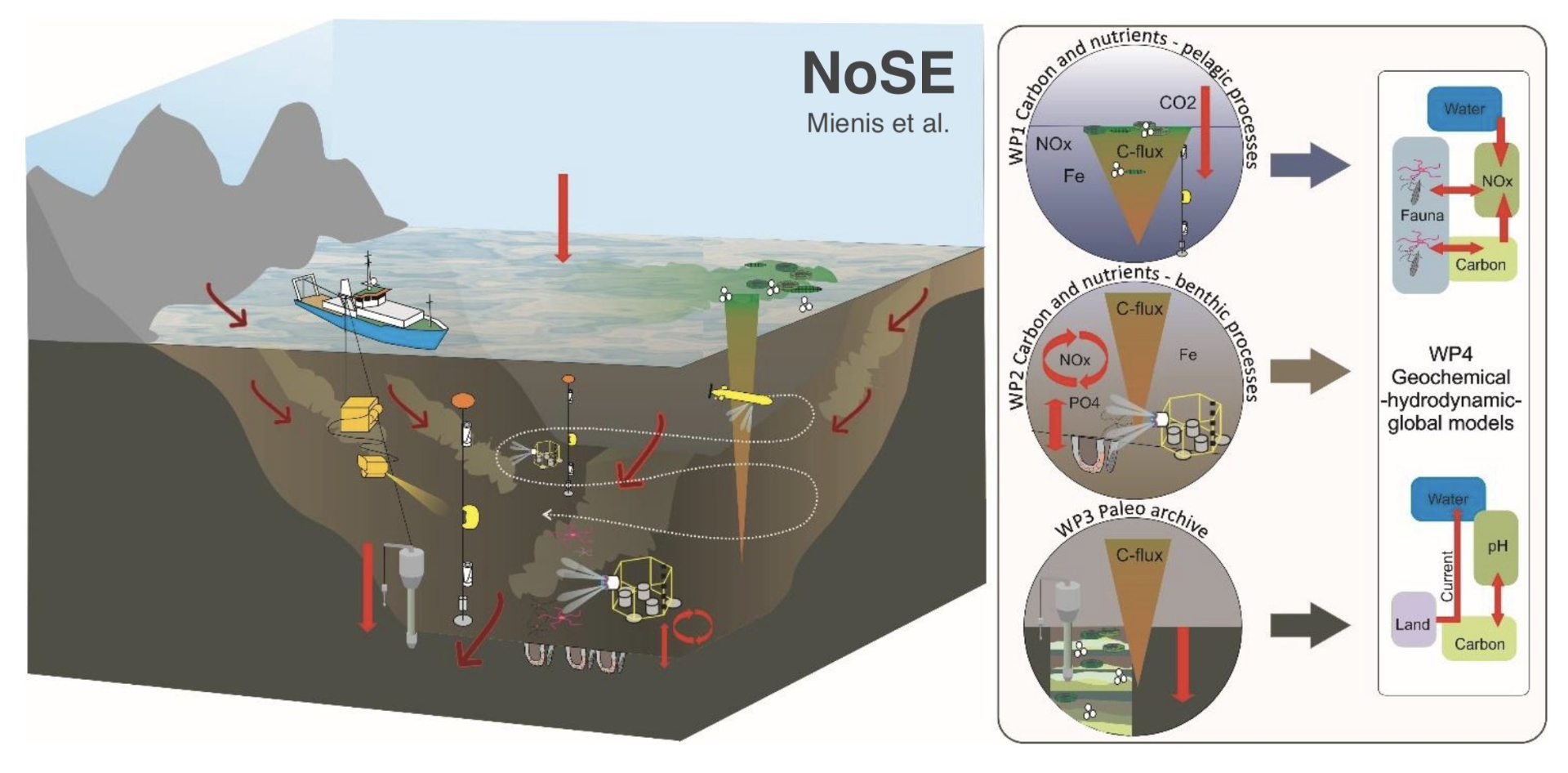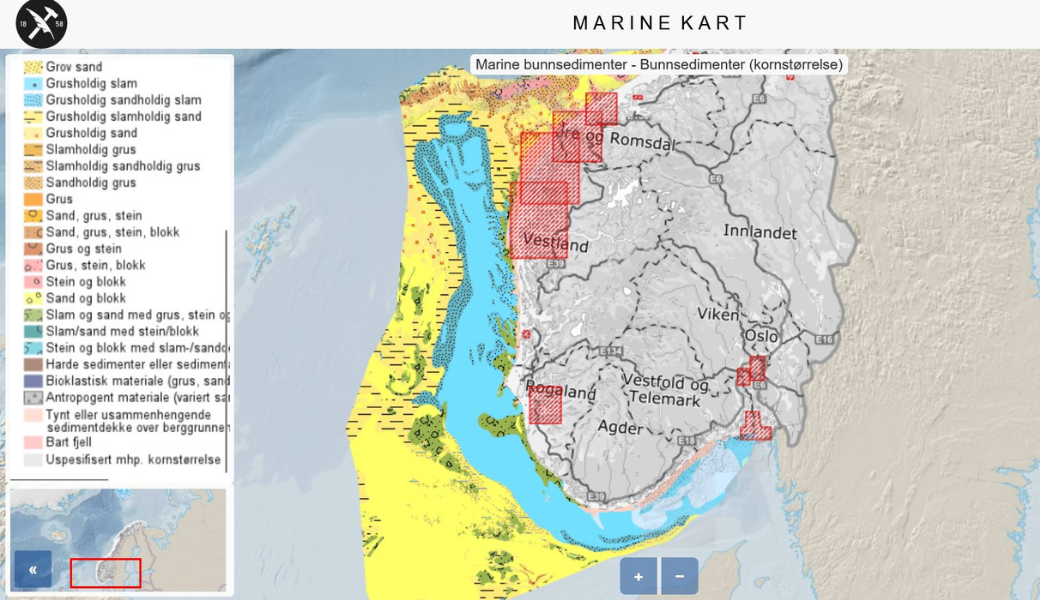On the 26th we sailed from Texel for a research expedition with the RV Pelagia to the Norwegian Trench. This expedition is part of the NoSE project. During the expedition we will collect data and samples from the water column and the seafloor along E-W transects crossing the Norwegian Trench.
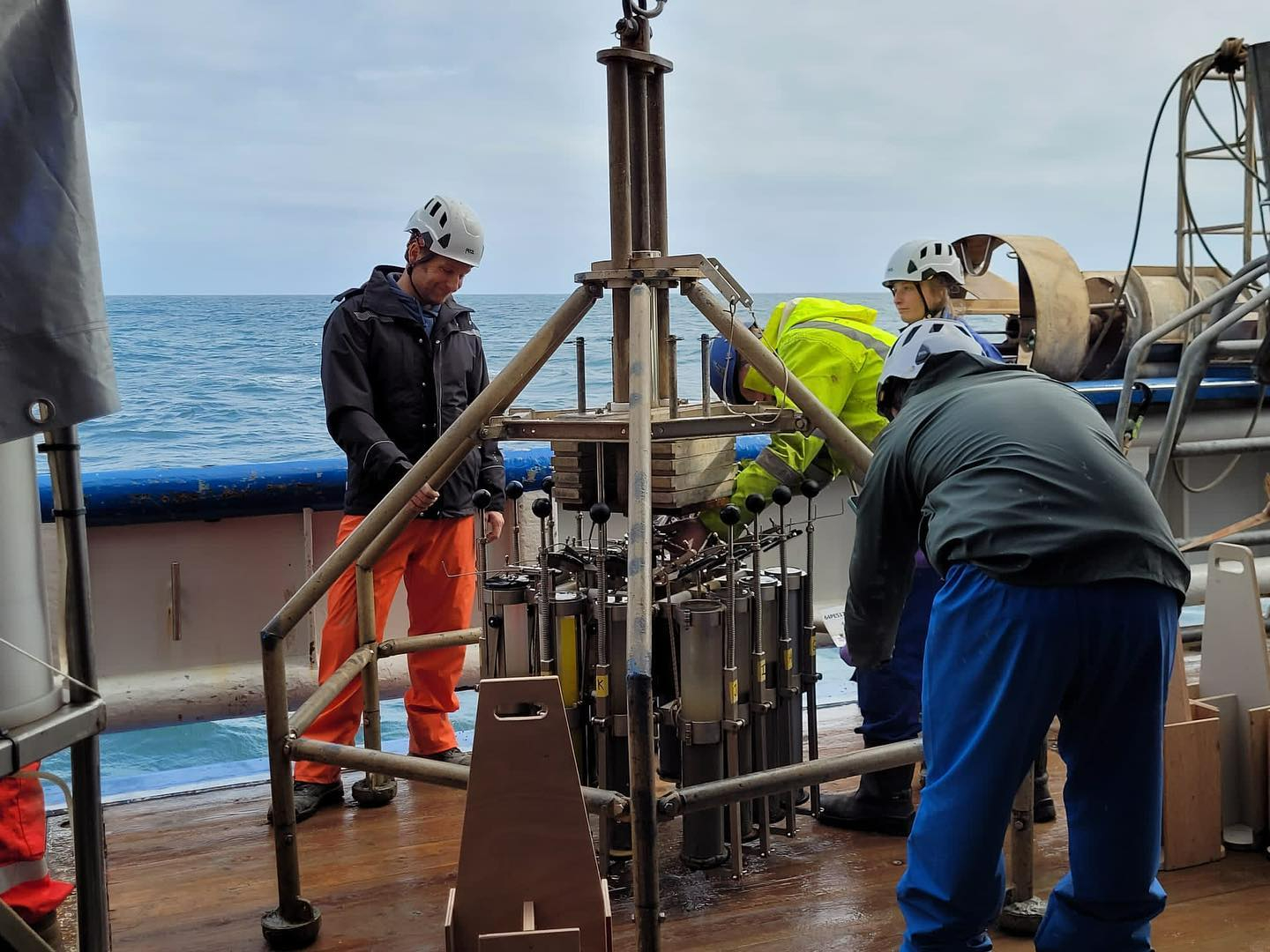
Thursday 1 June 2023
By Peter Kraal (NIOZ)
Working 24/7: the activity of fauna and microbes
As sediment geochemist, I am interested in biologically essential chemicals (oxygen, carbon, nutrients) that are consumed or produced in sediments by (micro)organisms and then released to the seawater. For this, we measure in great detail the composition of both the water and solids in the seafloor. They give us a wealth of information about how these essential chemicals are used and what role the sediment plays in storing them – for instance, think of carbon burial in the sediment as sink for atmospheric CO2.
But it’s only part of the story.
We want to know not only what is happening, but also the speed at which (micro)organisms are consuming and producing essential chemicals. For this, we need to go a step further and measure not only composition of water and sediment, but the rate at which it is changing. So, we designed a bunch of experiments and the equipment to go with it to measure the rates: O2 consumption by organisms in the sediment, transformation of nitrogen, release of phosphate, conversion of carbon from organic material to CO2… you name it.

Setting these experiments up at sea where everything moves is as rewarding as it is challenging! The organisms work 24/7, we get close to those working hours to be able to investigate them… And then, after the cruise, we will know what organisms are around, what they do and how fast they do it. Very important to understand the functioning of the Norwegian Trench as conduit for essential elements between the North Sea and the Atlantic Ocean.

Friday 2 June 2023
by Anna Enge (TU Delft)

I am Anna Enge, a PhD student from Technical University Delft. In February I joined the North Sea - Atlantic Exchange (NoSE) project. My research focusses on benthic processes. The overall aim of the NoSE project is to identify the exchange of carbon between the North Sea and the Atlantic Ocean. Special attention is paid to investigate the function of the North Sea, especially the deepest part, the Norwegian Trench, as a net sink of carbon. In the context of climate change the outcomes of this project might provide crucial information to identify carbon dynamics in the North Sea.

For my research I aim to identify sediment transport conditions and characteristics in the Norwegian Trench. In general, sediment transport is dependent on two factors, the characteristics of sediment and the near-bed current velocities. If the current velocities are high enough to force the sediment to move (critical shear velocity) and the sediment composition is mobile enough to react to the forcing, lateral transport and/or vertical transport (resuspension) is induced.

During the cruise I use multi cores and box cores to obtain sediment samples from depths ranging from 100 to 500 m. From the samples I aim to identify the sediment characteristics e.g. grain size distribution and porosity, that in a certain range, enable or inhibit transport. For this purpose, I subsample sediment cores in 1 cm slices to identify the layering of the upper 10 cm of sediment. To obtain information about the current velocities in the Trench I will use acoustic backscatter instruments (ADCP/ADV) that will be deployed on moorings for one year on two locations in the Norwegian Trench. By this, I will gain information about mean velocities in the lower 20 m of the water column as well as variations caused by meteorological and seasonal conditions. As an on-board experiment I use an erosion chamber (Gust chamber) to identify critical shear velocities and the erodibility of sediment over a calibrated range from 0.01 to 0.65 Pa for various locations within and outside the Trench. The Gust chamber is a “combination of a spinning disk and a central suction to generate nearly uniform shear stress across sediments in a cylindrical container (Green Eyes LLC, U-GEMS Manual, 2015). The effluent water is analyzed for total suspended solids to estimate the concentration of sediment that is brought into suspension. This cruise is of special importance to collect a first bunch of data to estimate the interaction of sediment and currents within the Norwegian Trench.
Monday 5 June 2023
By Rick Hennekam (NIOZ)
A muddy blast from the past
Today the R/V Pelagia moved on to the next transect of our North Sea expedition. Spirits are high among the different teams aboard the ship, which all focus on different parts of the North Sea, from water column to deep into the sea bottom. The first two transects were already finished successfully. A “transect”, in our case, means a cross section through the deepest part of the North Sea (“The Norwegian Trench”), where at different points (“stations”) both the water column as well as the muddy and sandy sediments underneath are studied in detail. By studying several of these cross sections we want to improve our spatial understanding of the role of the North Sea in the carbon and nutrient cycle. Getting to the bottom of this is one of the important aims of our NoSE expedition.
We finished the last transect by reeling in a whopping 7.32 meter long piston core, which will form a precious archive of the past ocean (“paleoceanography”) thousands of years back in time. Muddy sediments from the seafloor are a core business for the two paleoceanographers onboard the R/V Pelagia: Cecile Hilgen and I have a specific interest in these seafloor muds, because they can inform us about how the environment changed over the last few millennia. The deeper you go into these sediments, the older they get. These sediments can thus inform us about how carbon and nutrients cycled through the North Sea and its muds before major human impact. They will form the baseline of natural variability of carbon and nutrients in the North Sea that we can use to compare to contemporary variability, which might already be greatly altered by human activities.

Our successful piston core catch is now safely stored in one of the fridges in the ships belly. Most of the sample processing will be done back home. By focusing on chemical and biological characteristics of the muds (so-called proxies) we can reconstruct all kinds of interesting past environmental conditions, such as sea surface temperature, the saltiness of the water, nutrients, and algae growth. These environmental conditions will tell us the tale the past carbon and nutrient variability and their links. By taking the core we just started opening the book.
Tuesday 6 June 2023
By Cuun Koek (RUG student)
Why would someone doing a PhD in climate modelling join a research expedition? A better question would be: why would you not?! For starters, there might be whales, which is cool. Secondly, for any person working with ocean data, it is a very nice (and I might even argue necessary!) addition to your research experience to see how data are collected.
In work package 4 (WP4) of the NoSE project, global and regional climate models will be used to investigate the response of the North Sea carbon cycle to future climate change. It is linked to all three other work packages, as the data and insights from wp 1-3 will be integrated into the climate models of WP4. Hopefully in the next four years, I will improve the global earth system model (ESM) EC-Earth based on smaller scale models as well as our observations and apply the ESM to make future projections. We will then use the projections to investigate how the North Sea system might change in the future.
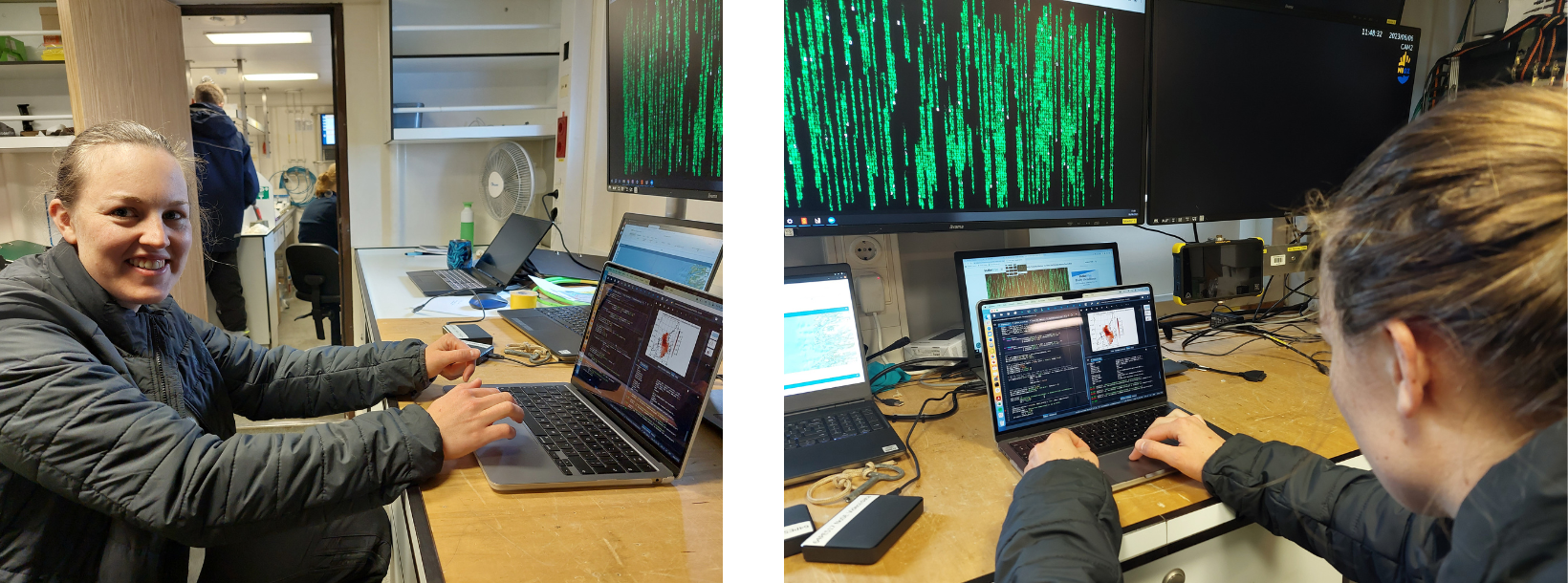
In the meantime on board of this expedition, I help out with the ultraclean CTD (Conductivity, Temperature, Depth), which we use to collect seawater from different depths. The CTD frame is made of titanium, so it can be used to collect water without contaminating it with all kinds of metals and trace metals. To find out what the water column looks like, the CTD is lowered until it is near the bottom, and then slowly moved back on-board while being closed at the depths of which we want water. Then the CTD is towed into a trace metal clean container and we sample water from the different depths. In this way, everybody on board gets the water they need for their different analyses!

Friday 9 June 2023
By Marieke Bos (RUG student)
Currently I’m doing my master research project in conservation ecology/ marine biology at the University of Groningen. I am really excited to be part of the NoSE expedition and to have more experience in the field, collecting my own data.
The expedition takes place at the end of the phytoplankton bloom, which is the perfect time for my research. The water column is stratified, and nutrients in the upper layers might become limiting. The question is which nutrients are limiting. Is this iron, a trace metal needed for photosynthesis, or nutrients (i.e. nitrogen and phosphate)? To investigate this, Willem van de Poll and me set up multiple bio-assays with different conditions (i.e. iron, nitrate/phosphate or both). When we get back on land, we will also investigate the taxonomic species composition of phytoplankton and the total biomass in different locations along the Norwegian Trench.
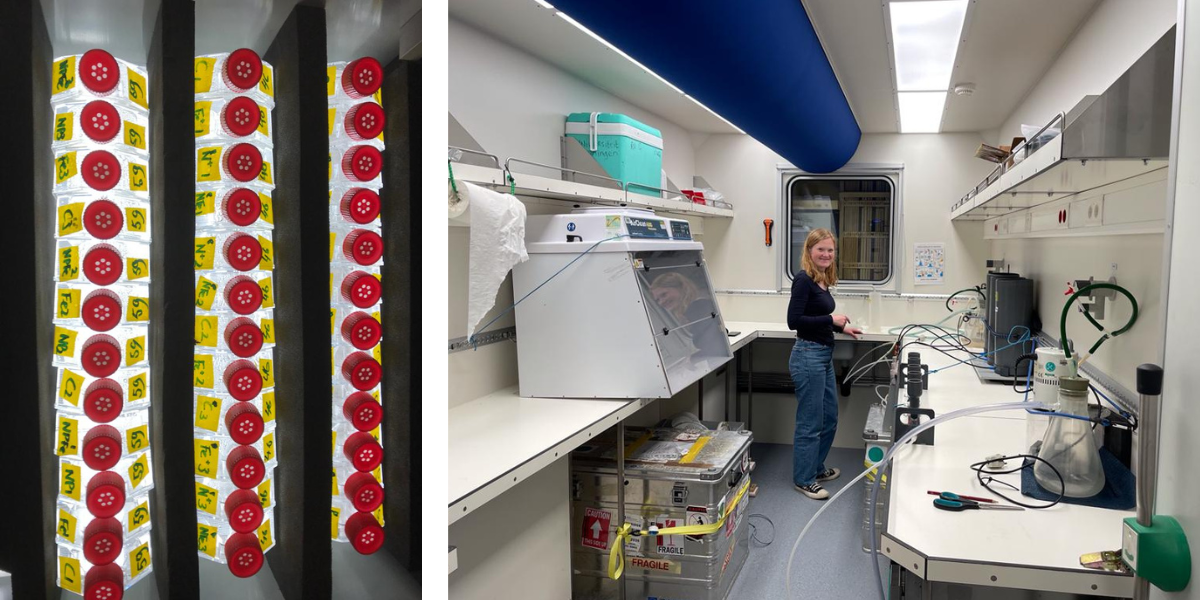
I am sampling the upper most layers of the water column, as well as the chlorophyll maximum (determined by a CTD). Then I filtrate the water samples for phytoplankton pigments, which will later be analyzed to obtain species composition and biomass. Furthermore, I take measurements on photosynthetic efficiency using FRRf (Fast Repetition Rate Fluorometry). Both the filtration and FRRf give some first insights in possible nutrient limitations during the expedition, which is very exciting!
Monday 12 June 2023
By Daan Temmerman (NIOZ)
The open ocean is often described as a vast empty space, a desert if you like, where resources are scarce and macroscopic life relatively rare. From the smallest unicellular organism to the apex predator, all are bound here in a ruthless scavenge for sparse sustenance. However, vast tracks of the temperate North-Atlantic, sub-polar and coastal seas undergo changes of extraordinary proportions a few times a year and are transformed from empty waters into very productive ecosystems theming with life. After the upwelling of nutrients from the depths as a consequence of winter mixing, the onset of spring stratification locks these resources into the rapidly warming upper ocean layers, creating ideal conditions for the growth of massive phytoplankton blooms. Planktonic grazers follow in the wake of these primary producers, attracting shoals of fish and other large animals. Suddenly, a complex food web has emerged over the course of only a few weeks in a place which was barren just before. These dramatic events occur over such gigantic scales, that they can even be observed from space, turning blue oceans into green ones.
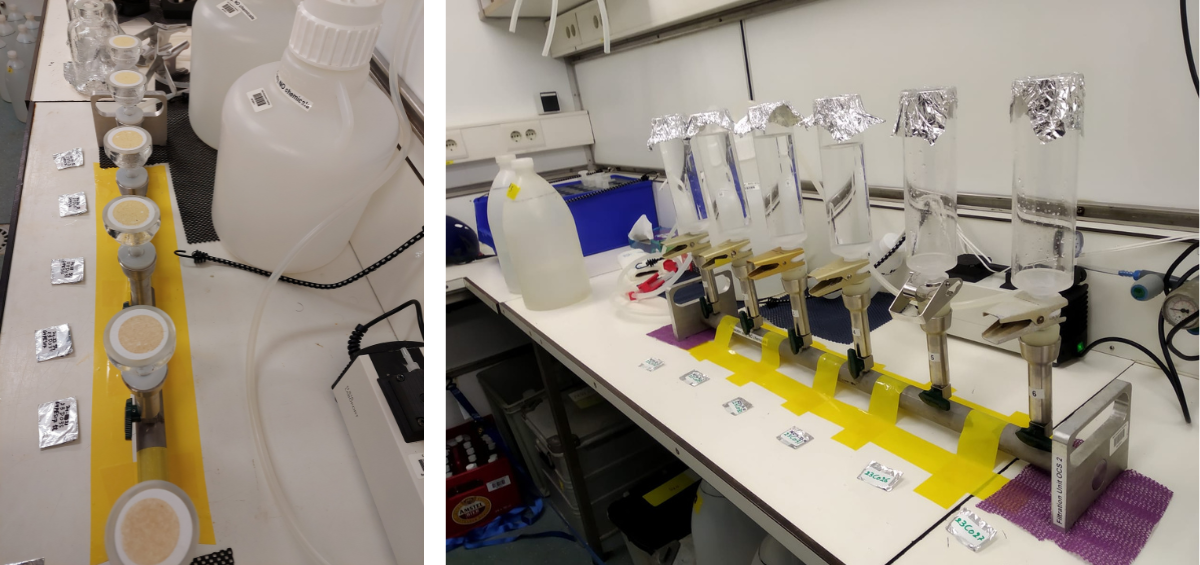
But once these nutrients are depleted in early summer, the initial phytoplankton bloom collapses and the death organic matter begins to msink to the ocean depths. This ‘marine snow’ may even reach the bottom sediments and be locked away there for millennia. Some scientists now suspect that these annual cycles of growth and decay in our oceans are possibly one of the essential mechanisms that sustain a livable environment on Earth. This so-called ‘biological pump’ could be a vehicle for rapid elemental transport in an environment that purely on itself would not allow for such large material fluxes on such small time scales.
My name is Daan Temmerman and I am a PhD candidate contributing to work package 1 of the NoSE project. I am interested in the transportation and transformation processes to which suspended and organic particulate matter is subjected in the North Sea, and more particularly in the Norwegian Trench, the main outflow pathway to the Atlantic Ocean. In order to determine the dimensions of major and trace elemental fluxes and map their respective age, bio-reactive potential and origins, I need to collect water samples, filter them onboard over varying types of membranes using specialized set-ups, freeze-store them and subject these afterwards to specific chemical analyses in the laboratory back on land. During this first NoSE expedition, we have already collected water samples from over 20 different locations using an ultraclean CTD-frame, which can sample multiple depths during one deployment, and a benthic lander to account for diurnal variations in marine snow settling on the seafloor. Moreover, two permanent moorings equipped with sediment traps will be installed and, once retrieved, provide us with long-term data on flux dynamics. So far, the expedition has been quite a success as we were able to sample almost all planned stations. Once back on land, the analyses will quickly start and I am confident we will soon be able to begin uncovering the story of the ‘biological pump’ in our North Sea.

Tuesday 13 June 2023
By Cecile Hilgen (UU)
Hi, my name is Cecile Hilgen. I am a PhD candidate at Utrecht University in the department of Earth Sciences at the Faculty of Geosciences. Together with Francesca Sangiorgi (UU), Marcel van der Meer (NIOZ) and Rick Hennekam (NIOZ), I am part of work package 3.
The term "direct measurements" refers to data collected through artificial instruments, such as thermometers or satellites. While direct measurements are essential for monitoring present-day conditions (which is done by others on board), they are limited in their ability to provide a comprehensive understanding of past climates. This is when Rick Hennekam and I come in!

As the sun rises above the horizon and the water team has collected its water column samples, our mud team of 5 scientists begins an exciting day of sediment drilling! Our destination: the bottom of the Norwegian trench. Since we cannot go there ourselves, we have to use different instruments to bring the sediment to us. We use (1) the multi-corer to sample the top part of the surface sediments on a high resolution which hopefully includes the chemical fingerprint of the human-impact and (2) the piston corer which help us to retrieve deeper sediments up to the beginning of the Holocene. Every time we retrieved a piston core, we did a gamble about the length since you do not know beforehand!
To achieve a paleo-record we need to use these sediments as natural archives which record past climate conditions beyond the instrumental record. The sediments we collected are like time capsules, preserving a wealth of information about the past. Each layer represents a distinct period in history. On board Rick and I do the sampling of the sediments and at home we apply “indirect measurements” which are called proxies. By combining both direct measurements and proxy reconstructions, we can gain a more holistic view of Earth's climatic fluctuations over time. We will transform the depth scale to an age scale and use these proxies to determine temperature, salinity, nutrients, and other oceanographic conditions that prevailed over centuries and millennia. As we dive deeper into the sediments, we will analyse dinoflagellates which are embedded within the layers whispering stories of ancient environmental conditions. I am excited to discover the secrets of the North Sea's past which are waiting to be uncovered. Hopefully I can contribute to a better understanding of the role this region has played in the Earth's climate and gain insight into the driving forces behind global climate change today to ensure that our Earth is preserved.

Follow my personal experiences of ‘North Sea-Atlantic Exchange project’: https://www.polarsteps.com/CecileHilgen/7413400-north-sea-atlantic-exchange-project?s=CD25F1F4-42C9-4C26-A423-D677D4D2A030
Tuesday 13 June 2023
By Matthew Humphreys
During the NoSE expedition we used an ocean glider to collect high-resolution data from across the Norwegian Trench. The glider dives beneath the waves to measure continuously throughout the water column, day and night, returning to the surface every few hours to communicate with researchers on board the ship via satellite. It dives and climbs by adjusting its buoyancy with an oil-filled bladder, allowing it to glide through the ocean using very little energy.
The continuous measurements collected will be invaluable in understanding the processes operating in our study area. The complex circulation patterns mean that the water properties can change rapidly from moment to moment at any given location, and it is very difficult to capture this variability with more traditional sampling approaches from a research ship.

Ocean gliders are becoming an increasingly important part of an oceanographer’s toolkit, with significant cost savings relative to expeditions with research ships as well as having a much smaller environmental footprint. Depending on its configuration, a glider can operate at sea for a year or longer before needing to have its batteries replaced or recharged.
Having recently purchased 3 new ocean gliders, this was the first time that NIOZ researchers have independently run a glider mission. As with any new piece of complicated equipment, there was a steep learning curve, but it was a great success overall. We piloted the glider from RV Pelagia for 6 days before meeting up with it again and performing a smooth recovery.
We are looking forward to the next opportunity to use this exciting technology!

